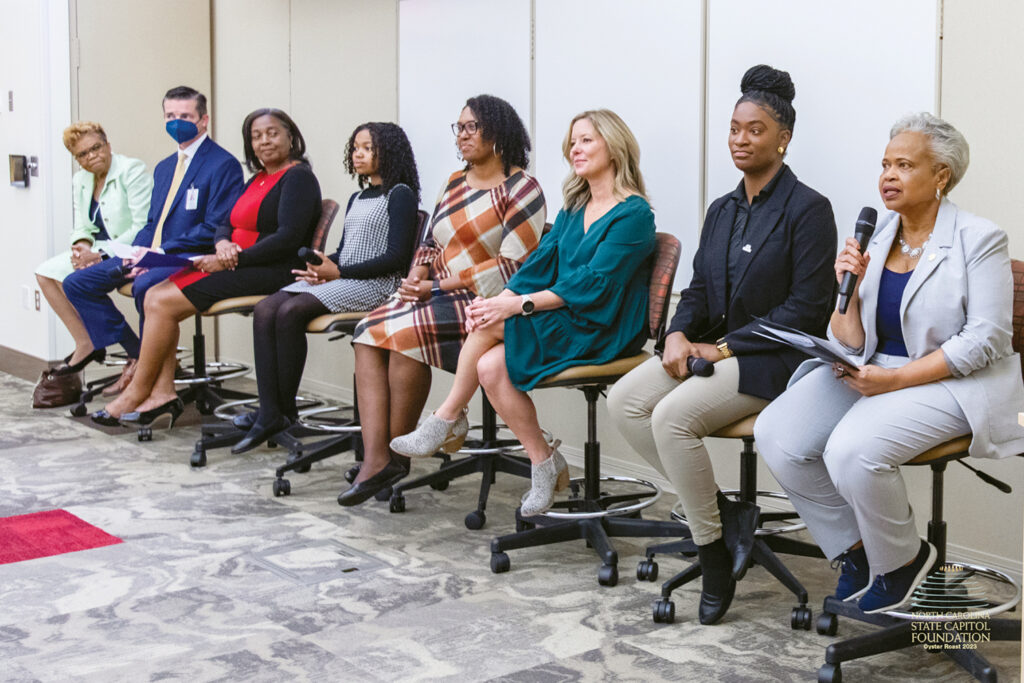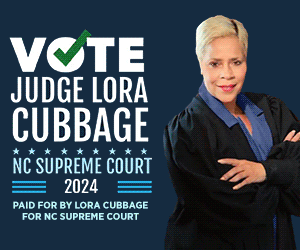School Meals for N.C. Kids
By Yasmine Regester, Staff Writer / October 20, 2023
Left to right: Dr. Goldie Wells (District 2), Greensboro City Council member; Travis Fisher, executive director of School Nutrition for Guilford County Schools; Bettye T. Jenkins, vice-chair of the Guilford County Schools Board of Education; GCS student Nadia Nicholson; Monique Nicholson, a North Carolina Parent Advocate and Nadia’s mother; Katie Dawkins with N.C. Alliance for Health; Kayla Holland, The Center for Black Health & Equity; and Gladys Robinson, N.C. State Senator (District 28).
One in six children in North Carolina experiences hunger on a daily basis. A collection of public health advocates are currently working to change that for all students across the state.
The Center for Black Health & Equity and Community Health Coalition hosted a School Meals for All NC Town Hall in Colfax, N.C. on October 13. The goal is to ensure that every child in public school in North Carolina has access to breakfast and lunch at school at no cost to their families.
The School Meals for All NC coalition is led by the North Carolina Alliance for Health, The Center for Black Health & Equity, Carolina Hunger Initiative, and A Better Chance, A Better Community.
This panel discussion featured elected leaders, public health advocates, parents, and students, who addressed ongoing problems and solutions for food insecurity for children across the state.
Bettye T. Jenkins, vice-chair of the Guilford County Schools Board of Education, noted that with full bellies, children are more likely to have higher performance grades and meet growth targets.
Gladys Robinson, N.C. State Senator, District 28, noted that the state is adding an additional $6 million to the Community Eligibility Program that provides funds to schools to pay for free and reduced lunch.
“We know that the kids who qualify for free and reduced lunch get the food, but what about those kids who don’t qualify? This will help close that gap,” said Robinson.
Kayla Holland, The Center for Black Health & Equity noted that the reduced lunch form doesn’t consider other mitigating factors that impact a family’s ability to pay such as if the child is a twin, if grandparents also live in the home, or other financial responsibilities.
“That current system of whether you are eligible or not is not the best system. What we need is access to meals for all students,” said Holland.
According to Travis Fisher, executive director of School Nutrition for Guilford County Schools, GCS now has 92 schools enrolled in the state Community Eligibility Program, which provides breakfast and lunch at no charge to eligible students.
“We’re not able to do every school in our district yet, that is why hopefully this panel will help us push forward so that we can,” said Fisher. “I never want any students to feel less than because it’s not their fault that they have a lunch debt.”
The USDA says that each school lunch should consist of at least three items: a grain, fruit, and a vegetable. Fisher added that some middle and high schools offer additional options, however, there is an additional charge. The “alternative meals’ that schools serve are different in that the entrée is left off the menu, but students are allowed to return to the line for second helpings of fruit or vegetables.
N.C. Public Schools’ lunch debt reached $3 million this year, with GCS lunch debt reaching more than $100,000 by the start of the 2023 school year. Once students owe around $20 or more in lunch debt– equivalent to five breakfasts and five lunches– the account is flagged for parental involvement and the student will receive a less expensive meal.
More than 23 percent of children in Guilford County are food insecure, according to data from the UNC School of Government Hunger Research. Hungry kids struggle with focus, deal with meal debt, and battle with ‘lunch shaming’ ─ the act intended to shame students and their parents into paying overdue meal bills to the schools.
The lunch options are different for the students getting free and reduced lunch compared to what other students receive.
GCS student Nadia Nicholson shared her personal experiences of witnessing classmates feeling embarrassed by having to step into a different line to get the free bagged lunch and often would not eat the meal.
“I know that some kids would have to step to the side and get a bag meal. It was not a good meal at all. Then kids have to go back to class feeling hungry and not able to focus,” she said.
Monique Nicholson, a North Carolina Parent Advocate and Nadia’s mother added that removing the stigma for parents filling out the forms and offering assistance with filling out the forms is necessary.
“How do we get more parents and guardians to fill out these forms? Whether you need free and reduced lunch or not, filling out these forms can help with the data that can potentially help with more funding,” she said.
For more information visit www.schoolmealsforallnc.org.







